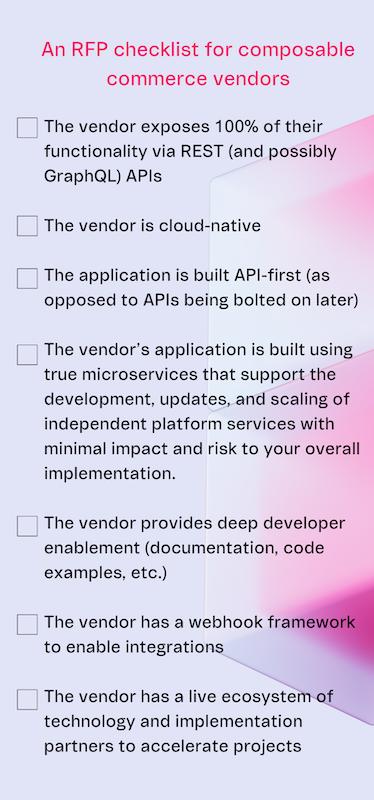Welcome to part 2 of the Decoding Composable Commerce series. Our first article explored the transformative power of composable software and its impact on commerce strategies. Now, let's dive deeper into the practical aspects of implementing composable commerce solutions and selecting the right solution for your business. If you missed that first article, you can read it here>>
Understanding your business needs
Before diving into composable commerce solutions, you must asses your business requirements:
- Are you and your business looking to enhance the business model and process flexibility?
- Are you focused on improving customer experiences and drive scalability?
- Do you want to future-proof your operations?
Simultaneously, you need to assess your technology requirements and maturity:
- Are you looking to gain complete control of your deployments?
- Are you prepared to implement and maintain several solutions?
- Do you have the team with the technical skills required to do execute a project?
Identifying your priorities and readiness will guide your decision-making process. If you answered yes to one or more of the questions above, you landed on the right article.
Evaluating Solution Providers
With a long list of vendors claiming to offer composable commerce, conducting thorough research and due diligence is essential. Look beyond marketing buzzwords and assess each provider's track record on technological capabilities, scalability, and flexibility.
An RFP checklist for composable commerce vendors should include the following items:

Assessing Integration Capabilities
First and foremost, composable commerce is all about interoperability and seamless integration of best-of-breed solutions. Evaluate how well a vendor's offerings integrate with your existing systems and third-party applications. To ensure a smooth transition, ensure compatibility with your preferred technologies and future expansion plans. Consider how well the vendor's solutions integrate with your current IT infrastructure, including legacy systems and third-party applications. This means you should look for vendors that offer robust integration capabilities and pre-built connectors for popular platforms. Assess the scalability and flexibility of the vendor's integration architecture. Finally, look for vendors that support industry-standard protocols and offer flexible integration options, such as RESTful APIs or event-driven architectures.
Finding the Right Implementation Partners
As crucial as evaluating the technical capabilities of potential solutions is, it's equally important to identify the right Systems Integrators (SIs) and middleware partners. Their expertise in orchestrating a seamless integration of various components within the composable architecture is critical.
These partners can help navigate the complexities of composable commerce, facilitating the integration of diverse systems, and ensuring cohesive functionality across the entire ecosystem. Additionally, having an experienced and adaptable team is crucial. You need resources with the right skillset and understanding of composable architectures to effectively leverage the chosen commerce components, manage the implementation, and swiftly adapt to evolving business requirements.
This all comes down to two main things: the tech capabilities and how well your potential partners can work with you. Your in-house talent must also be ready to handle this type of architecture. All of these criteria are important if you want to pick the right composable commerce solution to help your business grow.
Future Expansion Plans And Final Recommendations
Consider your organization's growth and expansion plans when designing your composable commerce architecture. Look for vendors that offer extensible integration frameworks and support for emerging technologies to ensure seamless integration as your business evolves. While interoperability is critical to tailor solutions to your specific needs, it's essential to strike the right balance between having native capabilities on a single code base and adding many 3rd part applications, each needing their own bespoke integration. Each of these integrations adds complexities and maintanence costs.
While this article has focused heavily on the technology side of things, it’s also important to remember that the role of technology is to support and accelerate needs of the business. At the end of the day, every technology decision must be made under the lens of “How will this benefit our customers?”
In the complex landscape of digital technology, choosing the right composable commerce solution, like VTEX, can unlock the full potential of your digital business strategy.
Are you ready to unlock the full potential of composable commerce and revolutionize your digital commerce strategy? Let's connect and explore how you can leverage a composable and complete commerce architecture your brand's success.
For more on the topic of composable commerce, check out these resources:
